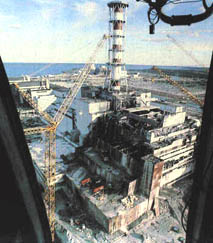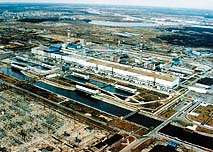| Previous: The Chornobyl Center for Nuclear Safety, Radioactive Waste and Radioecology | Next: More Chornobyl Information |
|
Deactivation, Decontamination, and Decommissioning
The U.S. Department of Energy is working with the Chornobyl staff to support the deactivation, decontamination, and decommissioning (DD&D) of reactor Units 1, 2, and 3. Reactor deactivation is the first step in this process. It involves defueling the reactor core, draining and drying the primary coolant system, and de-energizing some electrical systems and control systems. After this step, the reactors will be safe for an indefinite storage period. A survey of Chornobyl Unit 1 readiness and resources for deactivation was completed in February 1997. Future work also will include transferring knowledge of U.S. DD&D technologies and processes to Chornobyl and Ukrainian regulatory staff.Experts from the United States are working with Ukraine to establish a set of generic requirements for detailed DD&D planning and safety analysis. When this is done, Ukrainian engineers will adapt these requirements to the Chornobyl plant with U.S. support. This process will be repeated to establish requirements for safety analysis to cover plant procedures not included in existing operating specifications. As part of this activity, a comprehensive engineering survey of Chornobyl Unit 1 will be conducted to set a starting point for additional decontamination activities.
Initial studies and preparation of related documentation will be completed in 1997. Transfer of the necessary DD&D software and data to the Chornobyl Center for Nuclear Safety, Radioactive Waste and Radioecology will begin in 1997. The software will enable Chornobyl's staff to estimate costs for reactor decommissioning activities and assess the radiological and chemical risks associated with various decommissioning options.
A preliminary decommissioning study of the Chornobyl site
identified the need for a new heat plant. Chornobyl's heat plant provides
heat to help keep the Unit 3 reactor in a safe standby condition when it
is not operating. In an emergency during the winter, the heat plant also
would keep the reactor coolant from freezing and breaking the pipes. The
capacity of Chornobyl's existing heat plant, however, is insufficient to
support all of the decommissioning activities required. The U.S.
Department of Energy is working with Ukraine to find a cost-effective,
technically sound option to provide adequate heat at the site.
![]()
| Previous: The Chornobyl Center for Nuclear Safety, Radioactive Waste and Radioecology | Next: More Chornobyl Information |
 The 1986 accident destroyed the Unit 4 reactor building.
The 1986 accident destroyed the Unit 4 reactor building.
 Deactivation, decontamination, and
decommissioning of Units 1, 2, and 3 is planned for completion early in
the next century.
Deactivation, decontamination, and
decommissioning of Units 1, 2, and 3 is planned for completion early in
the next century.